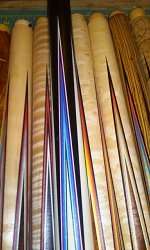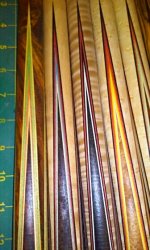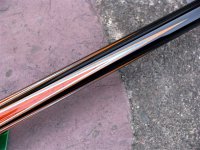The builders and more experienced owners know what they are talking about but I'm sure some of the newer owners are confused or don't understand what is being discussed here since there is some bouncing back and forth between inlays and splices.
Splices naturally come to a sharp point. There are many ways to cut them but all create angled "V" cuts in a blank. Then the other half of the blank, often with veneers is glued into the "V" cuts. When turned down the points are created. They come to a point from all three sides so they are very very thin. A moment's carelessness and a point is destroyed. That is why perfect full splice points are the mark of a skilled cue, or blank, builder.
Short splice or half splice joints are really inlays and don't take nearly the skill to create especially the round nosed ones created with NC or pantagraph. The difference between NC and pantagraph is pretty negligible and I used to get a chuckle out of people raving about the beauties of hand(pantagraph) work that was created by tracing a NC created pattern!
Sharp consistent points on a full splice take skills with both machines and a person's hands. Sharp points on inlays take decent hand skills, or better than decent! A highly skilled craftsman can cut a small pocket with four perfect points in less than a minute.
"Cheats" have been around since the days of the "masters" and more than one perfect ebony point is due to a sharpie or today's black glues. Today we can get black glues, white glues, brown glues, and pigments to color your own glue! Many a perfect fit has been filled in with glue. Once finish is over it, it is like Clairol, only the hairdresser or builder knows for sure!
As long as I am giving out trade secrets, those lovely veneers that people are so fond of? There is another word for them too, filler!
It takes a master to build a great cue. A good journeyman that knows the tricks of the trade can make a cue that plays well and looks like the cue of a master. Some of the cues from old masters used some of these cheats, they weren't masters when they first started building cues either! I remember a great stink when a high dollar cue was refinished and today's high resolution cameras and digital screens revealed a point had been cleaned up with sharpie! Turned out the original point had been cleaned up with a sharpie and the old refinisher simply redid the same trick as the builder.
I suspect when the wood ages fifty years or so, some of the greatest hitting cues ever are being built right now, today, on CNC. CNC can make a master's work easier and let them turn out more top quality cues. CNC can't make a master. That takes experience.
Just some rambling that started off to explain the difference between short splice and long, full splice and inlay, and got a bit carried away! :grin-square:
Hu



